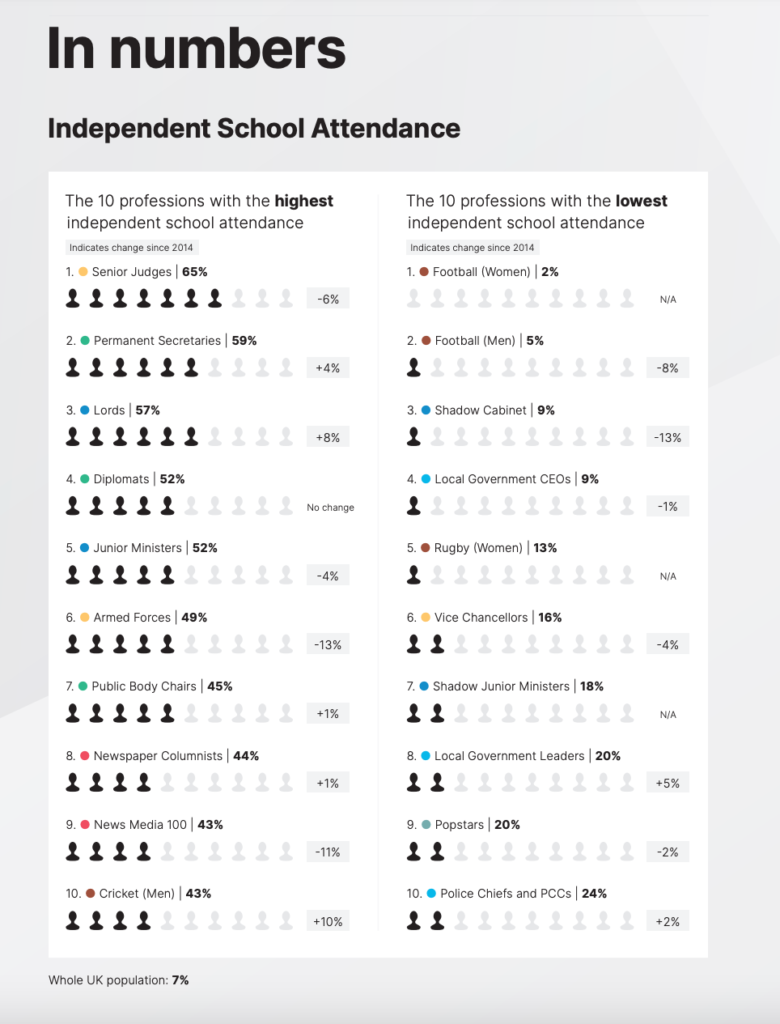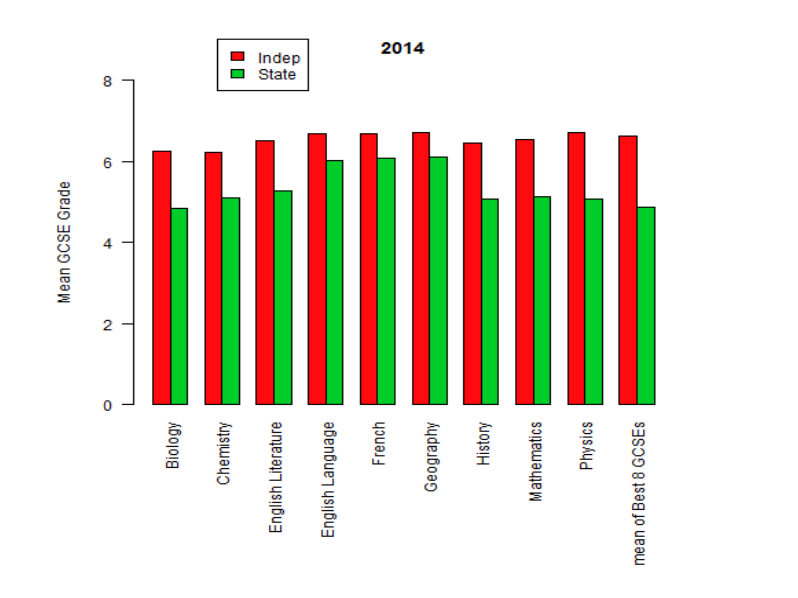Private (often referred to as independent) schools have existed for centuries and are located in each country in the United Kingdom (UK) (Exley, 2017), although they are predominantly situated in England, with a disproportionate number located the South-West. In England, around 7% of school-aged children are privately educated (ISC, 2017). Private schools are independent in their governance and are largely funded through fees which are to be paid on behalf of each pupil attending (Henderson et al., 2019). Although private schools are independent in their governance, they must comply with the Independent Schools Standards (DfE, 2019a). Private schools represent a small part of the British education sector, however, Green et al, (2017) argues that they play a significant role in British society and politics. Private schools possess approximately three times the learning resources in comparison to state schools, which may contribute to the significantly disproportionate number of privately educated people in high-status professions (Henderson et al., 2019). Additionally, Green, Anders, et al. (2017) suggest that the private education sector exacerbates social inequalities due to serving an extremely economically advantaged subsection of society.
Teaching at Private Schools
Since the 1980’s, the proportion of private-sector teachers has risen faster than the number of pupils attending private schools (Green, Anders, et al., 2017). There are around 78,000 private school teachers in England alone (Department for Education, 2018b). Statistics from the regulatory body for private schools, the Independent Schools Council (ISC) show that around a third of teachers at ISC regulated schools have arrived from mainstream, state education (ISC, 2017a, 2018a). Teachers at private schools do not have to possess Qualified Teacher Status (QTS); similar to free schools and some academies, private schools can employ professionals who they deem suitable to teach different subjects (Brady, 2020). Additionally, private schools do not have to follow the national curriculum (NC), nor do they have to adhere to the national teachers’ pay and working conditions (ibid, 2020). Micklewright et al. (2014) suggests that though there is little difference in pay amongst teachers in private and state schools. However, working conditions such as longer holidays, smaller classes and superior pupil behaviour (Green et al., 2008) mean that private school teachers are more likely to perceive their pay as fair in comparison to teachers at state schools.
Fees, Funding and Admission
In the UK, around 545,000 school-aged children attend ISC-member schools (ISC, 2022). This has declined since 2010, where there were around 628,000 pupils attending private schools in the UK (ISC, 2010 in Ryan and Sibieta, 2011). As previously highlighted, private schools do not receive direct government funding, however, if the school holds charitable status (which a large majority do), then it means that they are largely exempt from paying taxes (Ryan and Sibieta, 2011). The majority of private schools receive charitable status for owing to philanthropic histories and customs; which was estimated to relieve around £135,000,000 in taxes in 2014 (Wintour, 2014). On average, the fees are around £5000 per term for day schools; around £7,000 per term for day-pupils at boarding schools and around £15,000 per term for boarding students (ISC, 2022). However, around one third of pupils receive some help with funding (ibid, 2022). Private schools have varying admissions criteria, some may be faith-based, where-as some of the more academic schools may require formal testing to qualify for a position. Additionally, most will require a non-refundable admissions fee, usually ranging from £100-£300 (Best Schools, 2022). However, it is important to note that all schools, both private and state, must comply with the Equality Act 2010, which prohibits the discrimination of pupils and potential pupils who possess ‘protected characteristics’ (Department for Education, 2014).
Social Mobility
Attending private schools has often been associated with increased economic success and social mobility (Green et al., 2016). Social mobility is referred to as the link between an individual’s economic circumstances and that of their parents – where there is a strong link, there is lower level of social mobility, where there is a weak link, there is higher levels of social mobility (Social Mobility Commission, 2022). In the UK, children are around 8% more likely to attend private education if their parents had done so themselves (Ryan and Sibieta, 2011). Additionally, there is a significantly high number of privately educated individuals who are in the most senior positions (Sutton Trust, 2019). Those attending private schools have access to high-quality teaching, a wide variety of extra-curricular activities and excellent resources in comparison to state schools. Additionally, they are over seven times more likely to gain a place at Oxford or Cambridge University, and twice as likely to gain a place at a Russell Group University (Montacute, 2018). This suggests that social mobility is limited amongst children whose parents attend private schools, as there is little movement up the ‘social ladder’. Additionally, it further prevents social mobility amongst those of the lowest income as the senior positions are more likely to be secured by those from the highest-income background.

This graph displays the number of positions with the highest independent school attendance. Although only 7% of the school aged population were privately educated, it is evident that they largely dominate some of the highest paid positions in the country; this further impacts social mobility as positions are secured by those who have a financially secure background.
Exam Results
Children attending private secondary schools achieve an average GCSE result of 6.68 (grades A – B), compared to state school children, who achieve an average of 4.68 (grades C – D) (Ndaji, Little and Coe, 2016). Ibid (2016) proposes that attending private school is the equivalent of attending an extra two years of state school by the time a child is aged sixteen.

In 2021, 4.4% of private school pupils taking seven or more GCSE subjects achieved all grade 9 (A*) compared with 0.6% of pupils attending academies (Lough, 2021). It is important to consider wider socio-cultural factors which may contribute towards the attainment differences amongst private school pupils (Green et al., 2016). These factors include being from a family that can invest in education, as well as having cultural awareness and a strong network of ties which may secure a well-paid position in the labour-market (Bingley et al., 2011). The concept of cultural capital was first explored by Bourdieu (1977), and refers to an individual’s understanding of the dominant culture within society, especially regarding an individual’s capability of using ‘educated’ language (Sullivan, 2001). Ibid (2001) argues that the education system assumes that everyone possesses such capital, therefore is tailored to benefit those of the highest class.
Regulatory Bodies
Prior to the 1990’s, private schools were not subject to inspection; although the Children’s Act 1989 required boarding provisions to receive inspection (Brady, 2020). When OFSTED launched in 1992, the ISC proposed that they could inspect their own schools (Peel, 2018). This was the beginning of the Independent Schools Inspectorate (ISI). ISI are appointed by the DfE to inspect independent schools in England, as well as British independent schools overseas (ISI, 2022a). The ISI works alongside OFSTED and both organisations share knowledge to promote best practice (ISI, 2022b). Peel (2018) suggests that the introduction of ISI was a response to an ‘age of greater transparency’ (p.118). Although ISI is similar to OFSTED, they rate different components of the school as ‘excellent’, ‘good’, ‘sound’ and ‘satisfactory’; where-as OFSTED rate the overall quality of the school as ‘outstanding’, ‘good’ or ‘requires improvement’ (Brady, 2020). The inspections conducted by ISI are Regulatory Compliance Inspection (RCI) and Educational Quality with Focused Compliance (EQI). The RCI checks that the schools’ policies and practices are compliant with the DfE’s regulations, where-as the EQI is centred around the overall quality of education (ISI, 2022c).
Georgia Kirk – 199020166.